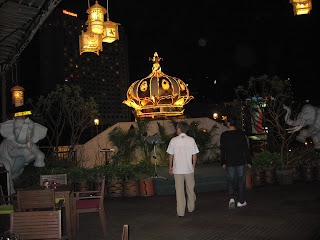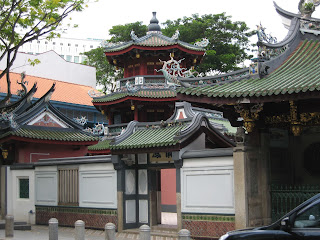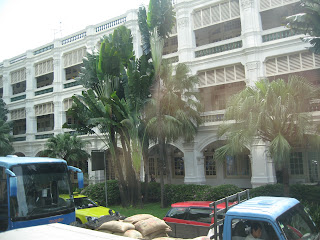By now, you may have noticed that our voyage takes us to many places, but for too short a time. Our choices while in port are usually way too many for the hours there. And we never want to be late returning to the ship or we get docked hours in the next port. Arriving in Hong Kong was beautiful early in the morning. They have mall after mall after mall right at the port all selling designer labeled goods. And not just one Gucci store, but 3 or 4 of them! Who buys all this stuff? There appears to be loads of money in this city! No shopping and bargaining here!! I’ll wait for China!!
 |
| Hong Kong Skyline |
 |
| Hong Kong from Victoria Peak at night |
Paul was not interested in seeing those two landmarks, so he sent me with a SAS group of students to Beijing. They were a good group and entertained me royally during those 4 days, especially with their slang and teasing. I helped out sewing on buttons and handing out safety pins and tissues in the bathrooms that had no tissue paper. After an especially funny conversation about current slang, I mentioned that when I was their age, we didn’t have all those crazy slang words and meanings like, “That’s bad!” meaning “That’s really good!” You know what I mean. Then we all said spontaneously, “How boring!”
 |
| Homemade Chinese feast in private home in the Hutong - no heat! |
We visited an orphanage of 107 children - no heat and not much food where we played games and painted a mural. The orphanage is run by a man and his wife without any state help. Everything is donated by corporations and people. It looks like a hard life there for everyone. We played games with the kids who were excited to have visitors. We helped paint a mural which we left unfinished when we ran out of paint. It was cold outside and inside their rooms. No heat yet! I went home to my warm hotel room and was haunted by those kids and their circumstance.
I have no idea how we could help them more. They are not 501c3 and they are in a communist country. Can one get money to them? Communism these days does not take care of the people. But they finally recognized that their philosophy was holding back progress and they changed to a capitalistic economic model. And BOOM!
 |
| Forbidden City on a cold day in November |
 |
| Huge screen at Tinneman Square erected prior to the Olympics - China propaganda |
 |
| Excited SAS students jumping for joy! |
Beijing and Shanghai city centers sparkled, especially Shanghai which lit up at night with stunning light shows along the harbor. Many of the buildings changed colors continuously. We could watch this show right out the window of our stateroom.
 |
| Shanghai Harbor at night |
The skyline and the scenes along the route to Suzhou's gardens and temples were all I saw of Shanghai because of the Beijing trip. The freeways in the city were lined with planters of small green bushes – a first for me!
 |
| Green lined highway overpasses in Shanghai |
Buildings are going up fast in downtown Shanghai, including a really fancy and inventive shopping mall on the waterfront, but many of the buildings are empty. The government is spending its huge surplus from the huge economic boom they are experiencing. The economic boom is very evident in the cities. Wish we ahd ahd time to visit rural China.
Paul arrived in Shanghai on the ship and accompanied my sustainability class and professor, Rocky, to an architectural firm which has designed an exciting “green” high-rise. This building will generate it own electricity via wind power, collect rain water, be fire safe, be taller than most buildings and be sustainable. That means fossil fuels will not be used to generate electricity. Everything possible will be recycled. And water usuage will be highly supplemented with rainwater. Paul did this for me since I was very interested but on my way back from Beijing and for Debbie who is LEED certified and interested. In fact, Rocky helped design a green building on the campus of his Sonoma University which reduced energy costs by 80% and produced extra energy. But that’s a whole other blog!
The areas outside of the downtown of those two cities were concrete forests housing the millions who live there. Those towers of apartments closer to downtown were in the $1.5 million range and all the same. So the masses live farther out and traffic is clogged almost all the time. In Beijing, those with even-numbered license plates can drive on Mondays and Wednesdays. Those with odd, on Tuesdays and Thursdays. Friday, Saturday and Sunday are unrestricted so traffic is bumper to bumper constantly. Bicycles are everywhere. Cameras are everywhere. Beijing city has 30 million people, 10 million cars and 5 million bikes! But they do include a huge area in that count – almost 17,000 square miles. I also noticed how the colors of clothing were usually on the darker side – blacks, browns and grays – on the rich, the middle class, and in the stores. This is quite a contrast to the colorful clothes in India and Vietnam!
To some extent, I was disappointed to not see the China I had read about for years. I wish I had the guts to do what Jules, a daughter in our extended family on the ship, did. She took a train into the country, rented a bike and traveled through the countryside letting the world happen! You can visit her website, http://www.julesduffin.com/ to learn more about her travels and her passion, child labor. In fact, she and her colleagues on the ship have started a non-profit to raise awareness and stop child labor in Africa. More information at http://www.thesenaseproject.org/.
Suzhou, China was more like the old China in my mind with its canals and bridges. The Grand Canal was constructed over 1400 years ago and is 1000 miles long making it the oldest and longest manmade river in the world. Paul and I visited the gardens which our friend, Arlene Shaw, had visited last summer and highly recommended. She was right – I loved this!
The day was cloudy, but the gardens were lovely in their fall dress. Each garden was unique. From hills, to waterfalls, to wandering paths, to special water springs, arched bridges, pagodas, temples, and limestone “mountains” from the 1500’s still tell their story. Peace. Sit. Listen. Observe. FengShui principles were used in these gardens to produce the greatest energy and peacefulness.
Think about those who lived in these royal places and padded around serving the Emperors. Think of the Emperors and their concubines. And tea ceremonies! I do find it difficult to imagine lots of children running around in these gardens, but they must have.
Lots of history to this country. Lots of Dynasties and Emperors and a couple of Empresses. Lots of royal court practices. The old ways. And the Chinese pride of having the “oldest, the longest, the largest in the world ” of whatever they are showing! Other than the sustainability class, the rest of my classes are really coming together in China and Japan: Women of the Royal Courts, World Religions, Asian Art, and World Music are all melding together and complimenting one another! How great!












































